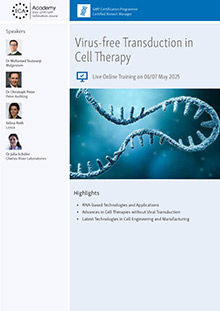THE NEW EU GMP GUIDE ANNEX 2: GOOD THINGS COME TO THOSE…
After almost six years and two drafts for public consultation the new Annex 2 of the EU GMP Guide was issued on 12 September 2012 and became effective on 31 January 2013. The revision had become necessary due to the tremendous developments and the increasing importance of biopharmaceuticals in the recent years. These developments also include transgenic products and ATMPs - Advanced Therapy Medicinal Products. The previous version just comprised five pages and thus only offered very few indications and guidance for biopharmaceuticals' manufacturers, and especially for young start-ups with little or no experience with GMP requirements. The increasing importance of biopharmaceuticals can also be recognised by their large share among the top sellers. Two thirds of the most sold drugs worldwide are biopharmaceuticals.
With close to 30 pages the new Annex is not only a better Guide for manufacturers now to recognise and implement the necessary GMP measures. It also causes something like a standard for authority inspections as it provides comprehensive definitions for the requirements and thus offers inspectors good directions.

An important change already shows in the Annex 2 title: the previous title "Manufacture of Biological Medicinal Products for Human Use" was changed to "Manufacture of Biological Active Substances and Medicinal Products for Human Use". The addition "Active Substances" demonstrates that the Annex can just as well be applied to manufacturers of biopharmaceutical active substances as to the manufacture of finished dosage forms.
In a table (see above) the Annex shows the growing GMP requirements for the various products groups and the steps in extraction, processing and manufacture of active substances and end products.
The new Annex now better fulfils the changing requirements and the diversity of biopharmaceutical products. In addition to the chapters on the scope of application and basics for the understanding of specifics of biopharmaceutical active substances, it now comprises the following two parts with various subchapters.
Part A provides additional details on the following subjects:
1. Personnel
2. Premises and Equipment
3. Animals
4. Documentation
5. Production
6. Starting and raw materials
7. Seed lot and cell bank system
8. Operating principles
9. Quality control
The general structure remained the same. However, a look at the single chapters and their sub items shows a much more exhaustive extent - which is not only shown by the increased number (from 43 to 70 sub items). Detailed data and additional specifications and descriptions offer a much better guidance than the previous Annex 2 version.
This becomes especially clear in the chapter "Starting and Raw Materials" which was completely revised, taking into consideration new cell based product types like transgenic products or ATMP - Advanced Therapy Medicinal Products. In this new version it also comprises a comprehensive part on cells and tissue as starting materials. This takes into account that these starting materials are a potential source for microbiological contaminations with mycoplasma, viruses or prions.
The chapter "Operating Principles" has also been clearly extended. It now contains important issues like change management, decontamination procedures and bringing in needed materials, virus inactivation and preventing cross contaminations.
Many biopharmaceutical products are also regulated by specific international and national guidelines and laws in addition to the GMP guidelines - as, for instance, the gene technology guideline or the Tissue Act to name a few. The new Annex often refers to these respective guidelines defining pursuing or additional requirements for the single biopharmaceutical active substances or products classes, which is very helpful for the reader.
In the the following groups the Annex' Part B covers specific requirements resulting from the origin respectively from the product types for designated biopharmaceuticals:
1. Animal sourced products
2. Allergen products - materials manufactured by extraction from natural sources as well as by recombinant DNA technology
3. Animal Immunosera products
4. Vaccines
5. Recombinant products
6. Monoclonal antibody products
7. Transgenic animal products
8. Transgenic plant products
9. Gene therapy products
10. Somatic and xenogeneic cell therapy products and tissue engineered products
In this part the Annex covers specifics playing an important role for the particular group. This includes, for example, controlling the supply chain with regard to animal sourced starting materials possibly coming from "not GMP regulated" areas such as slaughterhouses and thus requiring a special risk management and maybe additional tests.
Another example is the special attention to the consistent composition or quality relative to transgenic products with a higher risk compared to not transgenic products. The new product types gene therapy, somatic cell therapy and xenogeneic cell therapy are also dedicated exhaustive sections. These also cover recommendations with regard to the sources of used materials, the risk of contaminations especially regarding to used materials of human origin up to Cryopreservation.
Finally, the last Annex 2 section comprises a three pages glossary with explanations of relevant terms and abbreviations that are essential for understanding the text.
Conclusion
The new Annex 2 finally provides a much more precise and exhaustive scientific and GMP relevant guidance - even though the implementation and realisation took quite long. With the fast developments in the area of biopharmaceuticals it remains to be hoped that future revisions will be available faster.Author:
Axel H. Schroeder
CONCEPT HEIDELBERG





